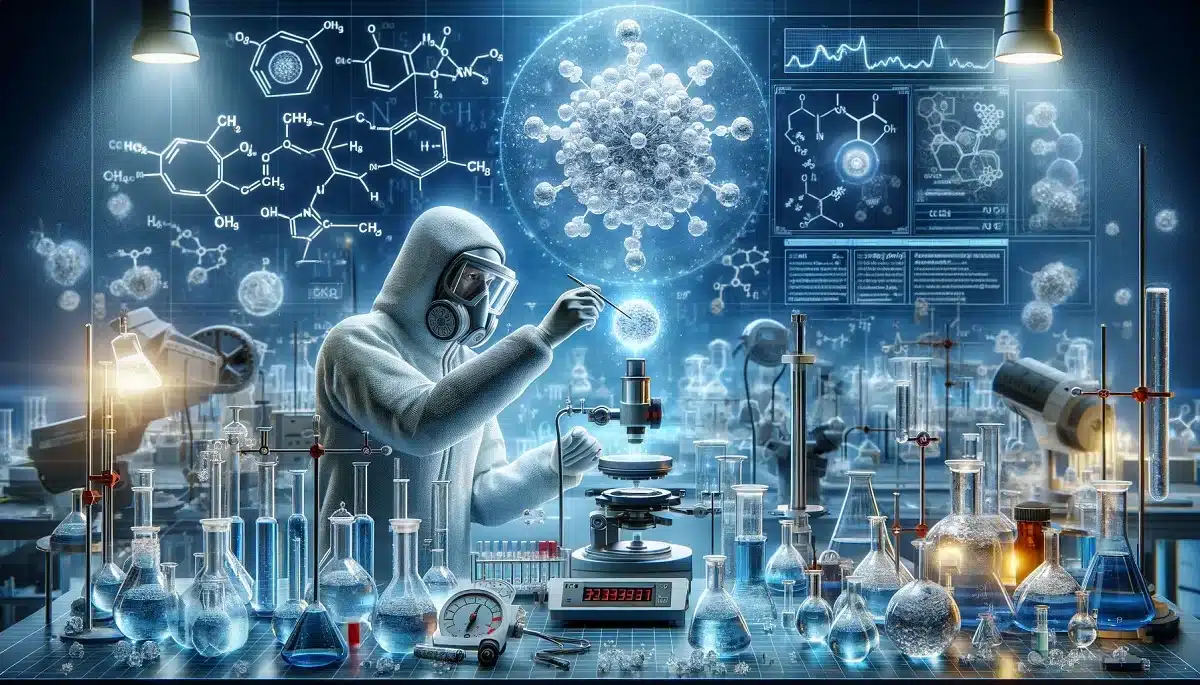In this article, we will delve into the fundamental properties, applications, and industrial significance of sodium sulfate in detail.
What is Sodium Sulfate?
Chemical Definition and Classification
Sodium sulfate is an inorganic compound with the chemical formula Na₂SO₄. Its chemical structure comprises sodium ions (Na⁺) and sulfate ions (SO₄²⁻), which define the basic chemical properties and reactions of sodium sulfate. Found naturally as mirabilite (sodium sulfate decahydrate) and thenardite (anhydrous sodium sulfate), it is an industrially significant salt.

Physical and Chemical Properties
Sodium sulfate is a white, crystalline solid in its pure form and dissolves upon heating in water. Its chemical stability and neutral pH value facilitate its use across various industrial applications. In terms of physical properties, sodium sulfate is a solid, white powder at room temperature, characterized by high solubility and good conductivity.
Properties of Sodium Sulfate
Solubility in Water
The solubility of sodium sulfate in water is a key factor in its application across various fields. As temperature increases, so does its solubility, enabling the effective use of sodium sulfate in solution form in diverse industrial processes and laboratory applications.
Resistance to Heat and Pressure
Sodium sulfate exhibits considerable resistance to heat and pressure. This property allows its reliable use in industrial processes that require high temperatures and pressures, especially in the production of glass and detergents.
Color and Structural Characteristics
The colorless and crystalline structure of sodium sulfate indicates its pure form. Pure sodium sulfate does not contain additional characteristics like color or odor, making it an ideal substance for analytical studies and various industrial applications. Its structural integrity renders sodium sulfate a stable reactant or intermediate in various chemical processes.
Chemical Equation and Formula of Sodium Sulfate
Meaning of the Molecular Formula
The molecular formula of sodium sulfate is Na₂SO₄. This formula indicates that each sodium sulfate molecule contains two sodium (Na⁺) ions and one sulfate (SO₄²⁻) ion. The ratio of these components determines the chemical and physical properties of sodium sulfate. The molecular formula provides essential information on how sodium sulfate will behave in chemical reactions, which is critical for analyzing or utilizing this substance.
Chemical Functioning of the Equation
Sodium sulfate can participate in various chemical reactions. For instance, its reaction with water underpins its solubility and dissociation into sodium and sulfate ions. The chemical functioning can influence how sodium sulfate is used in industrial processes and its environmental impacts. This functioning is a crucial factor to consider when processing the substance or managing it as waste.
Applications of Sodium Sulfate
Role in the Detergent Industry
Sodium sulfate has extensive use in the detergent industry. It serves as a filler in detergent formulations, which helps maintain the product’s effectiveness while reducing costs. Sodium sulfate enhances the consistency and fluidity of detergents, improving the free flow and moisture retention capacity of powdered detergents.
Significance in Glass Production
In glass manufacturing, sodium sulfate lowers the melting point and reduces viscosity, enhancing process efficiency. This facilitates the molding and processing of glass, reduces energy consumption, and increases the cost-effectiveness of production processes. Moreover, it improves the quality and clarity of glass, allowing the production of more durable and clear products.
Functions in the Paper and Pulp Industry
Sodium sulfate also plays a critical role in the paper and pulp industry. It is used to improve the structure of paper pulp and enhance the mechanical properties of paper. Additionally, it ensures color stability in paper production and slows down the paper’s aging process. Sodium sulfate is utilized in wastewater treatment within this industry, contributing to the reduction of environmental impacts.
Sodium Sulfate Production Methods
Obtaining from Natural Sources
Sodium sulfate is known to be sourced from natural origins. This method typically involves the extraction of sodium sulfate from minerals and salt lakes. Natural sources usually contain sodium sulfate in forms like mirabilite or thenardite. These minerals are found in various geographical regions and are extracted using direct mining methods. Extraction from natural sources is often preferred due to its lower energy consumption and environmental impact.
Synthetic Production Processes
Synthetic production processes are methods used in the chemical industry to produce sodium sulfate. These processes usually involve the reaction of chemicals such as sodium chloride (NaCl) and sulfuric acid (H₂SO₄) to produce sodium sulfate. Synthetic methods can be customized to meet specific industrial needs and typically guarantee the production of high-purity sodium sulfate. However, these processes can be energy-intensive and may generate harmful by-products.
Environmental Impacts of Sodium Sulfate
Waste Management and Recycling
Waste management and recycling of sodium sulfate during its production and use are crucial for environmental sustainability. After use, wastes containing sodium sulfate should be properly processed and recycled, if possible. Waste management strategies ensure that these wastes are treated and disposed of without harming the environment. Additionally, recycling processes promote the re-use of sodium sulfate, supporting efficient resource utilization.
Environmental Risks and Safety Measures
The use and production of sodium sulfate can pose environmental risks and require appropriate safety measures. If this compound leaks into waterways or soil, it can have adverse effects on ecosystems. Particularly at high concentrations, sodium sulfate can be harmful to aquatic life. Therefore, facilities producing sodium sulfate and industries using these substances must implement strict waste management and water treatment procedures to prevent leaks and accidents.
Current Research and Future Perspectives
Sustainability and Innovative Applications
Current research highlights the focus on sustainability and innovative applications in the use and production of sodium sulfate. Scientists and industries are exploring ways to make the production of sodium sulfate more environmentally friendly. In this context, methods that reduce energy consumption, minimize waste production, and increase resource efficiency are being developed. For instance, the recycling and reuse of sodium sulfate hold a significant place in sustainable production models. Innovative applications are also focusing on producing sodium sulfate in more eco-friendly ways using alternative raw materials.
Sodium Sulfate in Future Industries
In future industries, the role of sodium sulfate will be shaped by technological advancements and the evolution of market needs. Particularly in the fields of renewable energy, environmental technologies, and sustainable chemical production, sodium sulfate will continue to be an important raw material. In the future, the usage of sodium sulfate could diversify, and new application areas may emerge. For example, its use in energy storage systems or eco-friendly cooling solutions represents potential future application areas. In this context, the importance of research aimed at reducing the environmental footprint of sodium sulfate and enhancing its efficiency in industrial processes will increase.
Frequently Asked Questions About Sodium Sulfate
How is sodium sulfate found in nature?
Sodium sulfate occurs naturally in mirabilite and thenardite minerals, as well as in some salt lakes and mineral waters. These minerals are the most common natural sources of sodium sulfate and are typically extracted through mining.
What are the effects of sodium sulfate on human health?
Sodium sulfate is generally considered harmless and has low toxicity. However, when ingested in high doses, it can irritate the gastrointestinal system and cause diarrhea. Prolonged or high exposure can also lead to irritation of the skin and eyes.
Are there alternatives to sodium sulfate in industrial processes?
Yes, there are alternatives to sodium sulfate in some applications. For instance, sodium carbonate can be used as a filler in detergent production instead of sodium sulfate. However, the choice of alternative depends on the requirements of the industrial process.
What are the impacts of sodium sulfate on water and the environment?
Sodium sulfate is typically not harmful to the environment and dissolves easily in water ecosystems. However, discharging large amounts into waterways can negatively affect local water ecosystems, increase water hardness, and be harmful to certain aquatic organisms.
Can sodium sulfate be recycled?
Yes, sodium sulfate can be recycled in some cases. Particularly in industrial processes, a portion of the used sodium sulfate can be recovered and reused, which enhances resource efficiency and reduces environmental impact.
What changes are expected in the use of sodium sulfate in the future?
In the future, the use of sodium sulfate is expected to become more sustainable and environmentally friendly. Innovative applications and sustainable production techniques could enhance the efficiency of sodium sulfate while reducing its environmental footprint. Additionally, the exploration of new application areas and the development of alternative production methods are anticipated.
